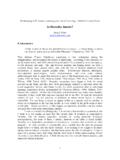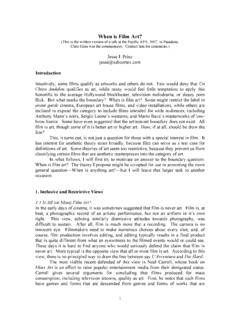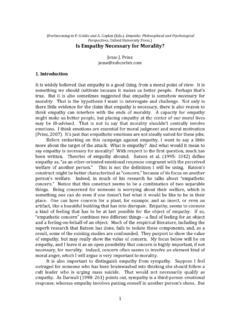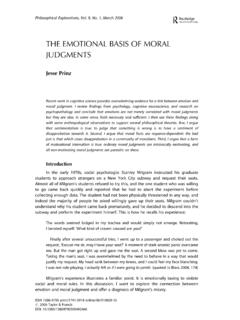Transcription of Which Emotions Are Basic? - Jesse Prinz
1 1 [In in D. Evans and P. Cruse (Eds.), Emotion, evolution , and Rationality, Oxford University Press (2004).] Which Emotions Are Basic? Jesse Prinz There are two major perspectives on the origin of Emotions . According to one, Emotions are the products of natural selection. They are evolved adaptations, best understood using the explanatory tools of evolutionary psychology. According to the other, Emotions are socially constructed, and they vary across cultural boundaries. There is evidence supporting both perspectives. In light of this, some have argued both approaches are right.
2 The standard strategy for compromise is to say that some Emotions are evolved and others are constructed. The evolved Emotions are sometimes given the label basic, and there is considerable agreement about a handful of Emotions in this category. My goal here is to challenge all of these perspectives. I don t think we should adopt a globally evolutionary approach, nor indulge the radical view that Emotions derive entirely from us. I am equally dissatisfied with approaches that attempt to please Darwinians and constructivists by dividing Emotions into two separate classes.
3 I will defend another kind of ecumenicalism. Every emotion that we have a name for is the product of both nature and nurture. Emotions are evolved and constructed. The dichotomy between the two approaches cannot be maintained. This thesis will require making some claims that would be regarded as surprising to many emotion researchers. First, while there is a difference between basic Emotions and nonbasic Emotions , it is not a structural difference. All Emotions are fundamentally alike. Second, the standard list of basic Emotions , though by many to be universal across cultures, are not basic after all.
4 We don t have names for the basic Emotions . All Emotions that we talk about are culturally informed. And finally, this concession to constructivism does not imply that Emotions are cognitive in any sense. Emotions are perceptual and embodied. They are gut reactions, and they are not unique to our species. To defend these heresies I will have to present a theory of what the Emotions really are. 1. Two Perspectives Evolutionary Psychology Evolutionary psychologists claim that Emotions are adaptations. They are species-typical psychological responses that evolved to serve various challenges faced by our ancestors.
5 Some defenders of this view restrict their claims to a small set of Emotions . The most famous of these are the Big Six, used in Paul 2 Ekman s research on pancultural recognition of emotional expressions (Ekman et al. 1969). The Big Six Emotions are happiness, sadness, fear, surprise, anger, and disgust. These have become the mostly widely accepted candidates for basic Emotions . They are thought to be basic in two ways: psychological and biological. They do not contain other Emotions as parts, and they are innate. More ambitious evolutionary psychologists argue that many more Emotions are biologically based.
6 Ekman (1999) has now expanded his basic emotion list to include: amusement, contempt, contentment, embarrassment, excitement, guilt, pride in achievement, relief, satisfaction, sensory pleasure, and shame. I will refer to the theories that restrict evolved Emotions to a small set as modest. Immodest theories are ones that try to accommodate many Emotions (see, , Ekman, 1999; Frank, 1988; Pinker, 1997). The most immodest theories claim that every emotion is part of our bioprogram. None is in any sense learned. Defenders of the evolutionary approach have brought various kinds of evidence to bear.
7 One strategy is to establish that certain Emotions are universal. While universality does not entail innateness, it can certainly provide some support. The fact that people universally believe that the sun is warm is not evidence for the innateness of that belief. The sun is warm across the globe. General-purpose learning abilities together with this shared feature of the environment are sufficient to explain the universal belief that that the sun is warm. Contrast this with the fact that people across different cultures have similar responses to music.
8 Many cultures isolated from each other have musical systems organized around octaves, and, across the globe, tonal music tends to be more prevalent than atonal music. Octives and tonal preferences can even be observed in macaque monkeys (Wright et al. 2000). No shared feature of the environment that can be used to explain this pattern. Likewise for colors. People who live in desserts, forests, and arctic plains seem to partition colour-space in similar ways, despite the fact that color boundaries find no obvious analogues in the physical world. It is natural to compare the evidence for emotion universals to the evidence for universals in colour perception and music.
9 Some Emotions seem to be found pan-culturally, despite significant environmental variations. Ekman et al. (1969) found that an isolated preliterate tribe in New Gineau, the Fore tended to associate facial expressions of the Big Six Emotions with the same kinds of situations with Which we associate them in the West. For example, most Fore respondents paired a disgust face with a scenario describing rotten food, they paired the anger face with an insult, and the sadness face with the loss of a child. Ekman et al. conclude that the Big Six Emotions are universal and biologically basic.
10 One can add further support to the evolutionary view by raising questions of learnability. The belief that the sun is warm can be learned given a general 3 capacity for belief formation. We acquire this belief on the basis of evidence. Contrast this with sneezing. We do not learn to sneezie by weighing evidence or drawing inferences. Sneezing is a involuntary response. We can fake sneezes, but real sneezes are outside of our control. Sneezing isn t the kind of thing that can be learned. Likewise for Emotions . Emotions are not like beliefs, so they cannot be aquired by weighing evidence.







